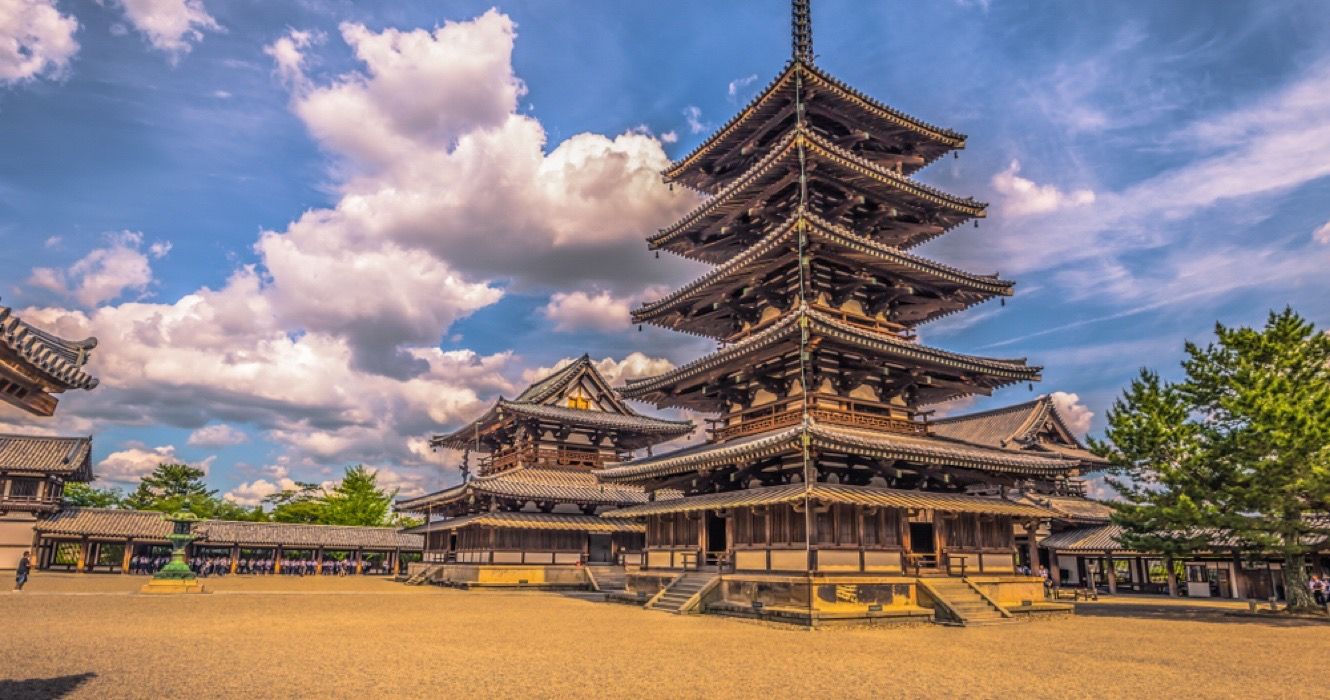Quick Links
There are travel destinations all over the world—and then there’s Japan. Known for being insanely clean, stunningly beautiful, and amazingly friendly—Japan easily sweeps travelers off their feet. But aside from the friendliness of the Japanese, the breathtaking beauty of the country, and her clean, unlitterred cities, Japan also boasts an abundance of spots so rich in history, mystery, and of course, cultural significance. Among these are a decent collection of magnificent temples, sacred shrines, and ancient medieval castles—spread out in various regions of the island country in East Asia. And the good news is that Japan has reopened again after the Covid-19 lockdown.
In this article, we talk about a Japanese temple that’s unique for being the world’s oldest wooden building. And to cut the chase, this is the Horyuji Temple near Nara. Here’s why the Horyuji Temple is a must-see.
Why The Horyuji Temple Is A Must-see
For starters, and as we’ve said, the Horyuji Temple features wooden structures that are the oldest on the planet. If there were no other fascinating elements to this rare gem, it would still deserve a visit for being in the Guinness Book of World Records for that remarkable feat. The Horyuji Temple was built in 607 AD. That means it’s 1,415 years old. We would still marvel at this—if the building was made of more enduring elements like stones, bricks, or metal. But wood is just beyond the pale. Even if we’ve known such species as the oak, cedar, and the African Baobab—to be spiteful of time.
Let’s touch a little on its founding. The man behind its founding and establishment was Prince Shotoku—whose role in introducing Chinese cultural and political influence to Japan is well documented. While the traditional religion of the Japanese had been Shinto—a religion with no known founder, no sacred text, and no fixed dogma—Shotoku would look west to China for attractive religious innovations like Buddhism and Confucianism. As a mark of his devotion to a new faith, albeit an alien one, Shotoku led out in the construction of this Buddhist temple. But it’s also said that Shotoku’s father, Emperor Yomei, had been infirm and that Shotoku built this temple, so he could pray to Yakushi Nyorai, the Buddha associated with healing—for his father’s recovery.
Things You Must See At Horyuji Temple
Together with the Himeji Castle, the Horyuji Temple is the first UNESCO World Heritage Site in Japan. There are many things in this temple—and about it—that would fascinate and intrigue a visitor. The temple itself consists of two precincts: The Eastern Precinct and the Western Precinct. In addition, there are other small temples within the bounds of this temple. Some notable buildings no one will want to miss seeing in the Western Precinct are the Main Hall and the five-story Pagoda. Also called the Kondo, the Main Hall is actually the world’s oldest wooden building—even if that description is usually (incorrectly) applied to the whole temple complex.
Inside the Main Hall, three canopies hang from the ceiling, embellished with phoenixes and other angelic beings. Under one of these canopies, Yakushi Nyorai, the venerated Budha of healing—calmly sits. In other sections of the Main Hall, visitors will find other Buddha deities—either sitting or standing. But whatever their different postures, all these deities look strikingly regal.
Then there’s the five-story Pagoda, a huge attraction in the complex. A pagoda is a tiered tower with many eaves. Therefore, the five-story Pagoda, as the name suggests, has five overhanging eaves. This is the oldest Pagoda of this kind in Japan. According to oral tradition, a portion of the ashes of Shakyamuni, the founder of Buddhism—is buried below the base of this 32-meter tall edifice.
Here’s What You Should Know If You Want To Travel To Horyuji Temple
Horyuji is about 7.4 miles outside downtown Nara, the capital city of Nara Prefecture—a landlocked prefecture in Kil Peninsula situated in central Japan. It’s about 22 miles from Kyoto and only 17 miles from Osaka, Japan's second-largest metropolitan area after Tokyo. Those who prefer to travel to Horyuji by train from Nara should board Yamatoji Line from JR Nara Station. This is a short, 12-minute journey that’ll cost about $12.6 (220 Japanese Yen).
- How Far is Nara From Tokyo, Japan? Nara is 22.3 miles (36 kilometers) from Tokyo, the capital of Japan.
For those traveling by bus, the pick-up point is either JR or Kintetsu Nara Station. From here, travelers should take bus number 98 to Horyuji. The journey can take up to about an hour, even if it’s just about 7.4 miles. Yes, Japanese buses can be slow.
- How Much Is The Admission Fee To Horyuji Temple? Admission to Horyuji Temple is 1,500 yen which is about $10.6.
That’s it. Visiting the Horyuji Temple is like looking at a piece of Japan’s transcendent soul. It will be more than rewarding.

